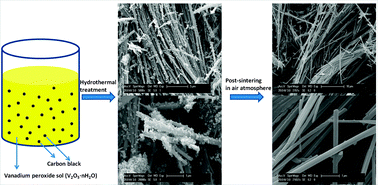Carbon black anchored vanadium oxide nanobelts and their post-sintering counterpart (V2O5 nanobelts) as high performance cathode materials for lithium ion batteries†
Abstract
Carbon black (CB) anchored vanadium oxide (C-VOx) nanobelts are successfully prepared by a simple sol–gel route and subsequent hydrothermal treatment. The synthesized C-VOx nanobelts display high specific capacity and good cycling stability as a cathode material for lithium ion batteries (LIBs) (232 mA h g−1 at initial discharge and 195 mA h g−1 during 50th discharge at a current density of 100 mA g−1 between 1.5–4 V versus Li) due to the nano-belted morphology and closely attached CB. The orthorhombic V2O5 nanobelts can be obtained by post-sintering of C-VOx nanobelts in air. These V2O5 nanobelts, which maintain their previous belted morphology and possess higher vanadium valence, exhibit superior electrochemical properties, especially the higher specific capacity (406 mA h g−1 and 220 mA h g−1 during the 1st and 50th discharge at a current density of 100 mA g−1, and 146 mA h g−1 at a current density of 1000 mA g−1 between 1.5–4 V versus Li). Both of them can be used as high performance cathode materials for LIB application. Furthermore, a full-cell using V2O5 nanobelts as the cathode and lithiated graphite as the anode is assembled and its electrochemical performance is measured in the voltage range of 1.5–3.8 V.


 Please wait while we load your content...
Please wait while we load your content...